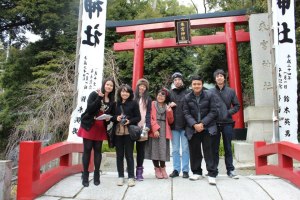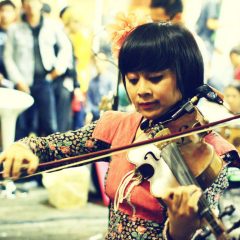Hello all!
I hope you all are doing well and fine, because here at Yokohama, it’s becoming quite cold (again) and it will rain until tomorrow 😀
This is, again, a very late post. Actually I really want to post about it from such a long time ago, but i just forget. Since yesterday I have just got my supervisor’s signature for Spring Semester Course Registration Sheet suddenly I remember about my intention to write this post 🙂
So in last semester (Autumn Semester 2012) I took 4 Classes, 3 with credits and one no credit class. As a Young Scientist Exchange Program student I took 2 compulsory classes which were Topics on Japan I and Study on Japanese Companies and Industries I. I took Japanese Class with no credit which was J1 and one class from my major which was Advanced Bioorganic Engineering. As an addition, I also had my Seminar and Sotsuron (Research) inside my lab.
And here I will explain a bit about each class, just in case someone is interested on this exchange program, for the full information you can just go here 🙂
Topics on Japan I (2 Credits)
Topics on Japan I is a compulsory subject for YSEP student and there we learn about Japan, it was taught by Yuriko Satou Sensei. From basic knowledge (from trivial facts and knowledge about Japanese societies), some history of Japan until some aspect about economic development and education of Japan.
This class was interesting because all the international students were mixed with Japanese student so here we can not only learn about Japanese culture and custom but also other country’s culture! We were asked to make group and give presentation about a country (we can present as our own country or other country). In that opportunity I present about Italy, mainly talking about its music, although some people said at that time it was more or less like a music class! 😀

From this class we are able to exchange ideas and deepen our understanding about Japanese society and in the end comparing it with other countries, thus knowing the strength and weakness of Japan.
The special features of this class are the inspiring special lectures and cultural activities. We have the chance to heard special lectures from David Zopetti, a Subaru Literature Price award Novelist. For the cultural activities we all could watch Bunraku (Japanese Puppet Theater) at National Theater with such a low price and we also had one day visit to Chisetsu Elementary School to do some sharing! 🙂

photo credits : Alfan Presekal
I think it is not hard to get high score for this test, you only have to attend all classes, special classes, participate in cultural activites, be active, and collect the final report (it’s 600-1000 words) 😀
Study on Japanese Companies and Industries I (2 Credits)
This class was also taught by Yuriko Satou Sensei. Only one word that can be said for this class : FUN! From the name, we can predict that we visit a lot of companies and industries to see how actually the industrial activities in Japan are. But, actually I think it’s only 20% of the course, the rest 80% is having a fun trip! 😀
First we visited Life Safety Learning Center where we experienced earthquake, fire-fighting, and fire simulation, it was really fun. We also visited Fujitsu Ltd., we had special lecture by someone from Gurunavi (it’s some kind of mobile application to find any restaurant near you, which’s pretty convenient to be used in Japan), visit to Nissan Motor Company and JFE Steel. Here are some photos, photos were taken from http://www.ryu.titech.ac.jp/~ysep/tour/tour.html



But what was very epic? During the Christmas day we were going to Atami, a city at Shizouka prefecture. Indeed, we still have lecture about job opportunities for foreigner in Japan, but I think most of the time we were having fun, enjoying the splendid city, soaking ourselves inside Onsen, eating marvelous dinner buffet, and sightseeing! On the way back home we also visited Asahi Breweries, yummy!


The score for this course i think was pretty easy, we only have to submit short report after each visit and the best of all, we did not have to submit final report that time!
Japanese Class J1 (no credit)
Actually Tokyo Tech’s system about Japanese Class is a bit confusing, and i don’t want to write something misinterpreted, so if you’re curious please just go here. Anyway i took the class without credit which was two times faster than the class with credit. In this class we were using 2 books which were Hakase 1 and Hakase 2 (roughly equivalent with Minna no Nihongo 1). The book was fun, i mean it had funny pictures inside it, and it did not contain as much grammar as Minna no Nihongo 1.
We got regular homework from the class, but mostly it wasn’t such a big deal, only one paper per one lesson. Beside that, the final test was not difficult and i think most of the teacher were very nice 🙂 We can also ask for a certificate to certify that we has passed this class to international student center. After this class we can continue to J2 or Jpb3, or even taking JLPT N5 (just like me!!)
Seminar and Sotsuron (6 Credits)
First sotsuron, is your research, basically the central part of your life here, lLOL. It weights 6 credits (i think mine weights much more). So once you arrived at Japan, for several weeks everyone in the lab will tutor you about how to use stuffs and do stuffs. After that your Sensei will decide in which subtopic of the lab’s research will you do research. Basically, we do progress report every 1 month or 2 month during the seminar time. Seminar is kind of gathering for the lab member, in my lab it’s only 2-3 hour per week, but the duration varies between lab and also the number of people inside the lab. There are some lab that can have seminar for whole day, usually they have more than 10 people inside. In weekly seminar we are told to read one paper related to our research and describe it to your friends, and also telling everyone what you have done during the past one week. But as i told you, once every 1 or 2 month, you will have progress report seminar where you have to make slide about your progress.
Advanced Bioorganic Engineering (2 Credits)
It’s a graduate class, but since it’s conducted in English, so I follow this class. The other reason why I took this class is because the first half is really related to my research (of course, it’s my sensei that taught the first half of the course). The first half mainly was about book which she edited (cool!), Future Directions in Biocatalysis.

It talks about novel reaction for biotransformations (like using other solvent than water such as ionic liquid), uncommon kind of biocatalytic reaction (like Baeyer-Viliger Monooxygenases), etc. Those few topics were really what we do in my lab. The last half was taught by Hisakazu Mihara Sensei. Mainly talks about synthetic DNA, and protein.
We are requested to one presentation about one paper and in the end one report about one paper. So it doesn’t actually give you that much burden.
And i guess that’s all for the class sharing, I hope that it can give you slight information about YSEP Classes and if you are interested please tell me! 🙂
Love
Afifa Ayu Koesoema
